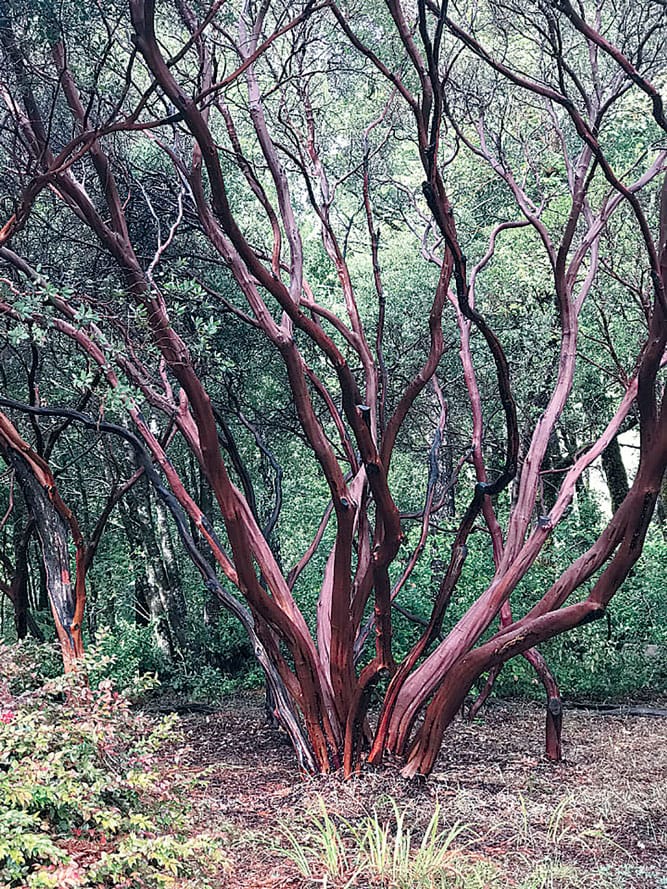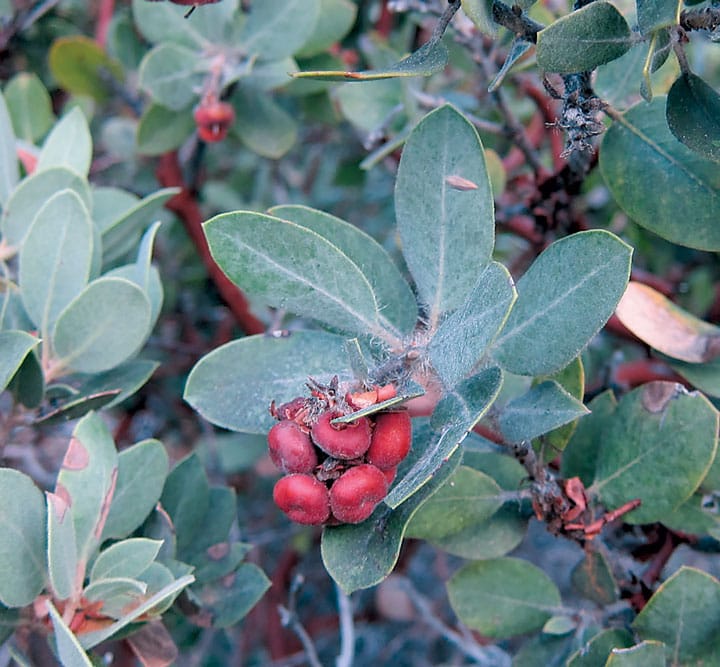Here in the northern California foothills, the manzanita tree is the first to grow in areas destroyed by loggers and gold mines, the places where the earth has been stripped, scorched and poisoned, desecrated for greed.
She can grow where there is not enough water, her wood dense enough to break a chainsaw. This hardy plant spreads out like a bush, covering the rocky wasteland, making shady spots over the dust where birds can stop and sing. She flowers early for the butterflies, bees and hummingbirds, and makes red berries for the later migrations of warblers and sparrows. She is a perfect perch for blue belly lizards to catch flies, and if there is some water nearby, for tree frogs to sing from at night. Deer, squirrels and bears also eat from her bounty. She is fire resistant and can live for hundreds of years.

Once established, her twisted limbs are impassable for human machines, making them an impenetrable shield for the area to keep the desecrators and destroyers away. This manzanita floating carpet of wildly entwined branches and sharply pointed leaves gives the land below the space to recover. This interwoven palace of vegetation acts as a protective covering over the wound while the ecosystem’s cells recoup and remake themselves. This snakes’ nest ball of tree-hair holds and heals, both fierce and kind.
While the wheel of the year turns, she mixes her potions of leaf, twig and animal droppings, dirt and decay to re-fertilize the soil. While other seeds blow in and stay, take root under the canopy, send up sprouts, eventually a pine tree will seed and another cedar tree, and the manzanita nursery will cuddle them until they are big enough to shoot through the ground cover and grow into the sky. As the forests return, the manzanita disentangles so the big trees and the smaller trees can live in harmony, sharing space in balance with each other.

Manzanita is an ancestor of this land, make her offerings. Give her well water, beaded necklaces woven with your own hair. Sing to her. Write her love notes on hemp paper and bury them at her roots. Manzanita is an untameable witch living in between the worlds and at the outskirts, remaking the world anew. Look to Manzanita for inter-generational resilience. For how to repel the endless attacks of empire, how to recover from capitalist destruction of community and patriarchal desecration of your body.
When she sheds her bark like a snake sheds it’s skin, collect some for your altar. Make it into an amulet to transform despair into action, to make that feeling in your bones stronger than any oppression while you lock arms with your community to protect your rivers and seas, your old-growth
forests, your children who birth new worlds, your desecrated lands, your endangered species, your ancestral wisdoms and wise mothers, your strong heart and intact spirit.
Who lives in your land? Which plant palaces live in your local groves? Who can make her magic there under the radar next to the underworld, can change the devastation into new shapes and new worlds that are no longer dead? Who rebuilds from the trash heaps, reclaims the wasted places and makes
them teem with life? Who lives in the cracks as empire crashes, making magic from bones and stones? Who is singing in the hidden places, chanting spells from the contractions of the birthing world? Which plants are your ground-breakers, your transformers, your healers?
To do this magic, you must go find them. Connecting to your local ecosystem for this kind of magical working is a part of its effectiveness.
Go now, the witch’s snakes await you.
Deborah Apple is a writer living in her hometown of San Francisco CA, where she was grown in an extended plot of storytelling relatives who never let truth get in the way of a good tale. She writes for the same reason that birds play with the wind, to flip, dip and twirl along the currents in complex choreographies that serve no practical purpose- not food or territory or competition- simply because it is fun. She has been published in the anthologies “Talking to Goddess” ed. by D’vora Grenn, “Anointed” ed. by Tess Dawson, and the Ashfar Theater Project’s “Letters to Gaza.” She has self published two books on goddess-oriented Judaic practice, "Flowers of Torah" and "Water, Wine, Tree & Vine." Look out for her third book on Jewish magic, “Woven by Moonlight,” coming soon.



